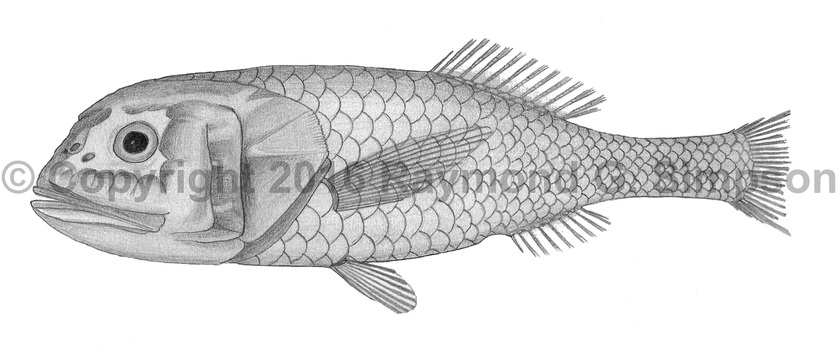
Common Name
Largeheaded Bigscale
Year Described
Koefoed, 1953
Identification
Dorsal Fin: III, 11-12
Anal Fin: I, 8
Pectoral Fin: 14
Pelvic Fin: I, 7
Caudal Fin: 9-10 branched, 2-4 procurrent rays
Lateral Scale Rows: 25-27
Gill Rakers: 23
Vertebrae: 24-25
Head with numerous bony ridges and pits. No post-temporal spines, projecting anterior spines, or raised bony crest on top of head. Head quite large compared to congeners (allometry?). Preopercle and opercle margins relatively smooth or with weak spination. Gill rakers in first arch relatively numerous (20 or more). Anal fin origin under the last 3-4 dorsal rays. Pectoral fin reaches last ray of dorsal fin. Pelvic fin origin well behind pectoral fin origin. Body scales large and easily shed.
Color
Body uniformly brownish with a reddish cast in the abdominal area.
Size
Maximum published size for five juvenile specimens: 22-28mm SL.
Habitat
Specimens in the Azores collected at around 3000m.
Range
Known from the northwestern Atlantic off Nova Scotia south to the seamounts off of New England. Originally described from the Azores.
References
Bartow, K. W. 2010. Taxonomy and Ecology of the Deep-Pelagic Fish Family Melamphaidae, With Emphasis on Interactions With a Midocean Ridge System. Unpublished PhD dissertation, Florida Atlantic University.
Keene M. J. 1987. Systematics and distribution of the deep-sea fish family Melamphaidae in the Atlantic Ocean. Unpublished Ph.D. dissertation, University of Rhode Island.
Kotlyar, A. N. 2004. Revision of the genus Scopeloberyx (Melamphaidae). Part 1. Multi-raker species of the group S. robustus. Journal of Ichthyology. v. 44 (no. 8): 537-554.
Moore, J. A., K. E. Hartel, J. E. Craddock, and J. K. Galbraith. 2003. An annotated list of deepwater fishes from off the New England region, with new area records. Northeastern Naturalist 10(2): 159-248.
Other Notes
Juvenile illustrated.
Keene (1987) described Scopeloberyx americanus from the northern Atlantic but this remains unpublished. The species was diagnosed by having a gill raker count of 20-23 which is within the diagnosis of S. robustus in Kotlyar (2004). The related Scopeloberyx rubriventer is diagnosed by Kotlyar (2004) with 23 gill rakers in the first arch, but only based on 5 juvenile specimens. The juvenile specimens may explain the uniserial teeth that are supposed to separate the species. Additional specimens of S. rubriventer from off the Bear Seamounts (Moore et al., 2003) were captured but no meristic information provided and “Scopeloberyx sp.” was also included that corresponded to the unpublished S. americanus_. Given Keene’s (1987) "_Scopeloberyx americanus" matches the diagnosis of S. robustus in Kotlyar (2004), the identity and validity of S. americanus is not known. The diagnosis of S. robustus in Bartow (2010) has higher gill raker counts than Kotlyar’s (2004) diagnosis of S. robustus, and is closer to S. rossicus or S. rubriventer. It is possible that Scopeloberyx americanus is attributable to S. robustus, and the higher gill raker count specimens are S. rubriventer, or that an additional species is actually present with these two species. Additional information is needed on Atlantic S. robustus complex material.